In this article:
Posture impacts the body a lot; that is why it is very important to improve your posture. Good posture means keeping your spine neutral. Good posture will keep the muscles balanced and support your body properly.

Good posture will prevent unnecessary lower back pain. Conversely, poor posture will contribute to tension headaches due to the increased muscle tension in the back of the neck.
When your posture is correct, your bones and joints will also be in correct alignment. This means less fatigue and more energy. This will also put less pressure and stress on your joints. (1)
Your spine plays a crucial part in maintaining correct posture. It has three natural curves, which are at your neck, mid-back, and lower back. Correct posture means proper maintenance of these curves, and not increasing them.
Your head needs to be above your shoulders, and the top of your shoulder should be over your hips.
How to Observe Proper Posture
Here’s how you can improve your posture:
1. Sleep on your back
Sleeping on your back is a very good position to improve your posture while you’re asleep. It will not only promote improved alignment of your spine but will also decrease any applied pressure on your arms and legs.
People who suffer from neck and back pain find sleeping on the back most comfortable.
To further help your posture, you can put a soft pillow under your knees to reduce pressure on your spine. This will also promote the natural curve of your lower back. A pillow under your neck will make sure your neck will stay aligned with the chest and lower back. (2)
Mattress selection is also important to support a healthy posture. You should choose a firm mattress with a box spring set that does not droop. If required, you can put a board under your mattress or put your mattress on the floor temporarily.
For someone who is habitual of sleeping on a soft surface, it can be hard to shift to a hard surface. So, you should take your time to find the right mattress and box spring according to your needs.
2. Avoid heels
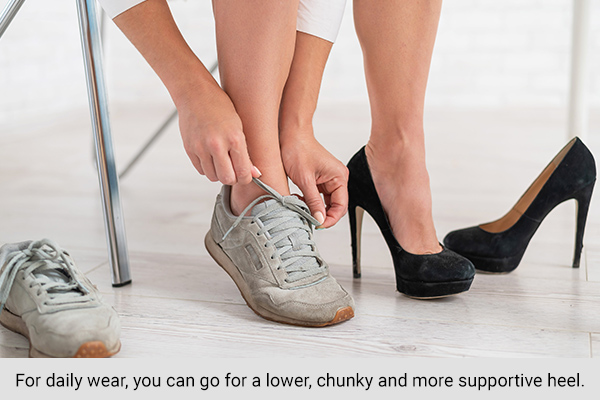
A lot of people wear high heels daily. These kinds of shoes can put a huge amount of pressure on your feet, especially your toes. They’re also not good for your posture as they negatively affect your knees, feet, spine, and ankles. (3)
A good pair of heels can make you go ecstatic, but you have to remember wearing heels every day is a big NO. For daily wear, you can go for a lower, chunky, and more supportive heel.
High-heeled shoes can be linked to conditions such as:
- Lumbar hyperlordosis: The inward arch on the lower back, which causes back pain
- Pelvic anteversion: The excessive inward twist of the knee
- Knee valgus: A deformity of the lower leg characterized by angling out of the knee joints
- Chronic foot issues
- Leg and back pain
3. Avoid arching your back or hunching over
Devices have been a big part of people’s daily lives. From computers to phones and tablets, people hunch over to use them. This involves tightening of the chest muscles and lengthening of upper back muscles, which leads to neck and back pain.
When you work for long durations using electronic devices, you tend to hunch over for hours, putting stress on your cervical and thoracic spine while protracting the shoulders. This can cause your muscles to get way out of shape.
Therefore, it is better to position your computer or tablet screen at eye level so that it is much easier on your back and neck. Make sure your elbows rest comfortably at your sides on the table. Also, your forearms should be parallel to the floor. (4)
Beware of “text neck”
Many people are on their mobile phones for a long stretch during the day, which has given birth to a whole new type of problem, known as the “text neck.”
What happens is that whenever you lean your head downward to check your messages or do anything on your phone, you strain your spine. This unnecessary burden on the spine eventually adds up, leading to health problems.
It is better to lift your phone up and move your eyes instead of your head.
4. Sit correctly while using a laptop
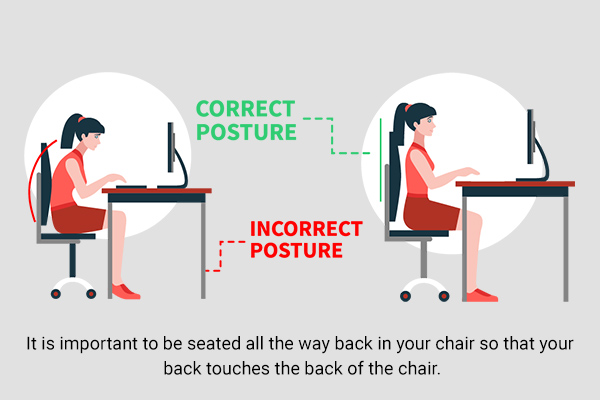
When using a laptop, it is important to be seated all the way back in your chair so that your back touches the back of the chair. You can also add a small rolled-up piece of cloth or a lumbar cushion behind your mid-back to maintain your spine’s natural curve.
Furthermore, make sure your knees are bent at a right angle and are at the exact height, if not a bit higher, than your hips. Your feet, on the other hand, should lay flat on the floor.
5. Do not cross your legs
Crossing your legs while sitting will not lead to an immediate health concern, but in the long run, it can lead to poor posture. Sitting with legs crossed is associated with increased blood pressure.
But at the same time, it is important to note that sitting in any one position for long durations is not ideal, be it legs crossed or not.
Studies have shown that crossing your legs while sitting can cause spinal issues such as scoliosis. So, you should make sure to not make it a habit. (5)
6. Use a lumbar support pillow
Lower back pain can be resolved by using a lumbar support pillow, which is used to support the lower back while lying down in bed. It will also improve the quality of your sleep.
Moreover, a lumbar pillow will also support your spine by filling any gap between your chair and lower back. This will not only improve your posture but also support the natural curve of your spine.
In addition, a lumbar pillow will relax your muscles and thus will keep tiredness at bay. It’s also a quick way to get relief from pain. (6)
7. Perform regular exercises
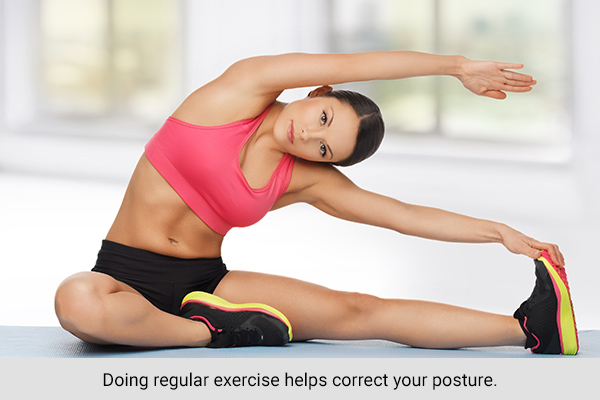
Doing regular exercise helps correct your posture. This improves the balance of your body and relaxes your muscles.
Exercise is one of the most common ways to improve your posture by strengthening your core. The core muscles or your abdominal and lower back muscles connect to your spine and pelvis. So they’re important to help your body move and to flex and rotate the spine.
Even in sports, core strength is very important as it promotes balance and postural control in movements. (7)
If any of the above-mentioned approaches result in an elevation of your pain levels or cause the spreading of pain to the legs, stop the exercise immediately and seek professional advice.
Additional Tips to Improve Your Posture
Apart from the tips mentioned above, following these additional tips can help you ensure a good posture.
1. Remain active
Staying active and avoiding a sedentary lifestyle by performing exercises such as Tai chi and yoga are great for strengthening your core and avoiding bad posture.
2. Maintain a healthy weight
Obesity or having extra weight is linked to weakening of your muscles and being problematic for your spine. This can be bad for your posture.
3. Wear the right footwear
Wearing the right footwear is extremely important for correct posture. Avoid wearing heels, and only wear shoes that will help you stay balanced and avoid putting too much pressure on your muscles.
4. Observe the right posture at work
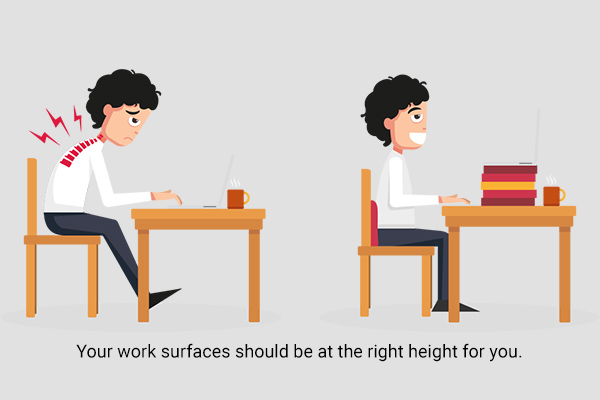
- Your work surfaces should be at the right height for you.
- Do not sit for long durations in the same position/posture.
- Walk around the office every once in a while.
- Your feet should touch the ground when you sit and work.
- Keep your shoulders relaxed and pulled backward.
- Bend your elbows to around 90 degrees.
- Support your back with a comfortable pillow to support your back’s natural curve.
- Your thighs should be parallel to the floor.
- Your seat should be well padded and hips supported.
- Wear clothing that is a bit loose or slightly fitted. Wearing very tight clothing is not good for your health.
5. Other tips
- Be conscious of your posture during routine activities, such as watching TV, washing dishes, or walking.
- Smoking can gradually cause you to lose control of your posture. So, it is best you avoid and quit smoking.
Most-Asked Questions About Improving Your Posture
What’s the correct walking posture?
Try to walk tall whenever you’re walking. This means you should keep your head high and upright. Your eyes should always look straight. Keep your shoulders well squared, and make sure your weight is distributed evenly on your feet. (8)
Why should I not sit for long hours?
Sitting for long durations without changing your posture can lead to tension in your back and neck. This can lead to pain in your body and will cause increased stress and less energy levels. It will also reduce the flow of blood.
So, it is best to stretch and walk every few minutes of sitting. (4)
Which yoga asanas are good for improving posture?
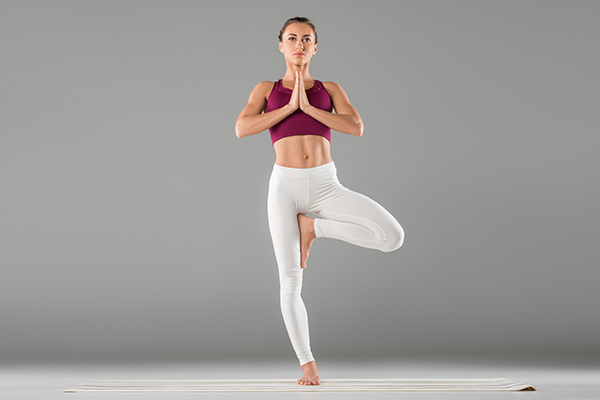
Here are some yoga asanas that can help improve your posture: (9)
- Tree pose
- Child’s pose
- Locust pose
- Downward-facing dog pose
- Standing forward bend
- Cobra pose
- Mountain pose
Final Word
Posture affects your physical and mental well-being. Bad posture can cause bad quality of sleep and can even lead to breathing problems. It can also bring about joint issues and difficulty waking in the future.
So, it is important to make sure your posture while sitting, standing, sleeping, and walking is well maintained to keep your body in proper alignment.
- Was this article helpful?
- YES, THANKS!NOT REALLY


